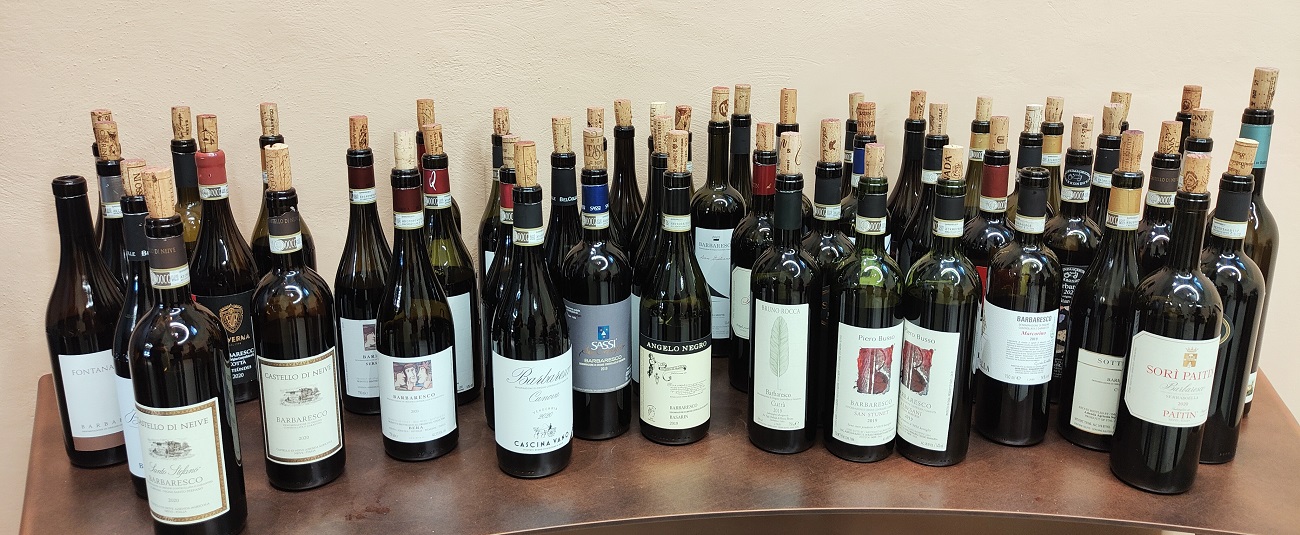
Climate change & Piedmont – Tortona 2024 (part I)
Climate change conferences are not rare lately but I try to visit (or follow online) as many as I can. First of all there’s always new information, research and studied aspects of the phenomena, second – they are a good platform to exchange experiences and get updates on institutional advancements. Most of these conferences have also a practical side with various experiments / techniques / policies already performed, results gathered and analyzed and conclusions done. Those who work in agriculture go there not only out of curiosity but also out of despair. Tortona’s conference was nothing short of all that.
The first part was dedicated to general issues concerning environment and society, meteorology, soil fertility, plant deseases and impact on wild fauna. Many things have been said numerous times, I’d like to point out some particularly interesting moments.

Claudio Cassardo, Turin University – Climate emergency and its impact on water resources and the territory
Claudio made some comparisons between global temperatures going up and how are they related with Italy:
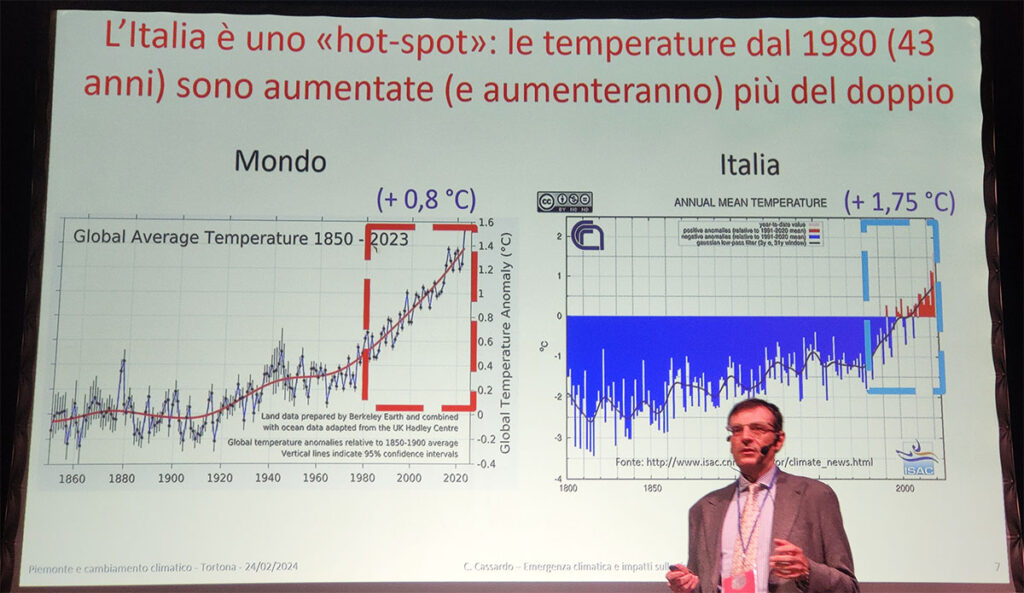
Globally the temperatures between 1980 and nowadays rose by 0.8 C, while in Italy the raise was +1.75 C for the same period.
[my thoughts] I am not a global warming negativist, I know there’s one as I feel it on my back every year working in the vineyards. And I’ve noticed that we’ve been consistently showed data only since 1800 and on, with the excuse that there were no meteo measurements and registrations prior to that year. But there are other methods to extract such data and here’s one example – a graphic by Prof. Attilio Scienza from a covid-times online lecture:
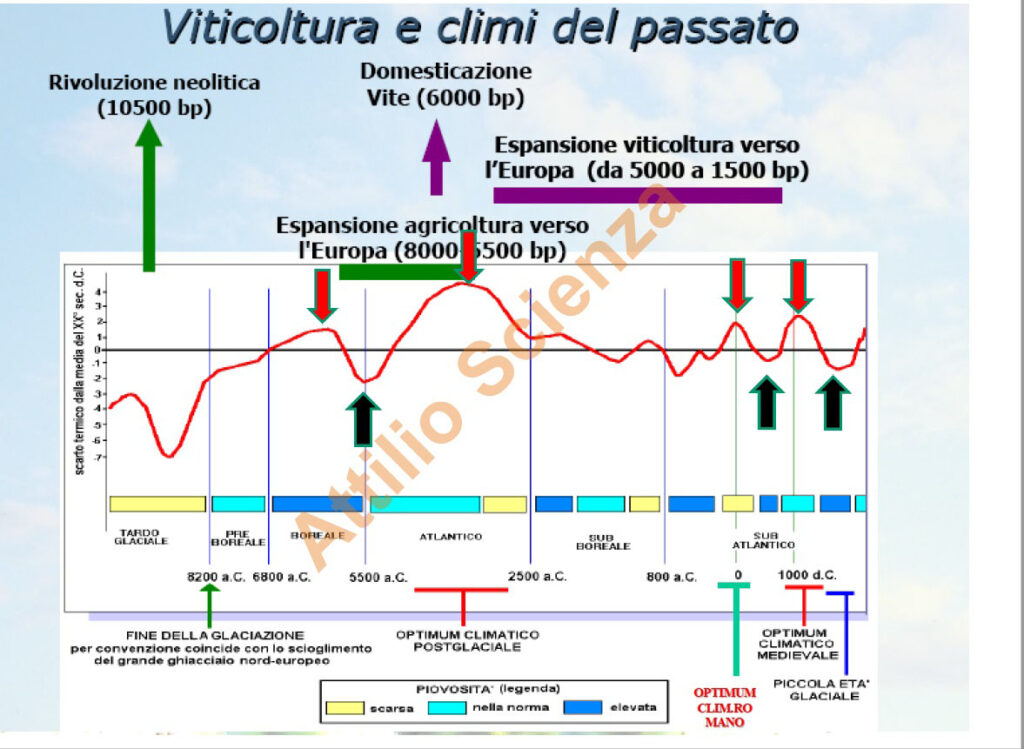
The red arrows point to the 4 previous periods of global warming. The first one, to the level of which we’ve nearly arrived, happened 8000 years B.C. and that was when agriculture started expanding across Europe. The third one, called the Roman Optimum reached its peak the year when Christ was born. That was the period when the Roman empire reached its best, Rome thrived and ruled the (known) world. Have you ever come across statues or pictures of ancient Romans in winter clothes? You haven’t as it was hotter back then, than now. The fall of the Empire more or less coincides with the global cooling down that followed the Optimum. The 4th temperature peak happened around the year 1000 and is known as Medieval Optimum. And it was even hotter than during the Roman Optimum. And that was exactly the time when viticulture started developing in Piedmont. It seems quite logical, doesn’t it? Please also note that the Roman Optimum was quite a dry period (scarce rains) while the Medieval one was definitely wet and rainy. The second optimum – the Post-glacial is the one that lasted more than the others – 3500 years. During this period the vine was brought to Europe. And the temperature difference then was nearly +4 C. We are at +0.8 C at the moment. That’s why currently there aren’t yet any vineyards in the Northern part of the British islands and there exists historic evidence that there used to be (reported during a two day international zoom conference back in covid-times, organized by Dr. Dimitri Van Limbergen from the University of Ghent, the transcripts of which I have unfortunately lost when my old phone died). So is global warming so scary and bad as (most of the) scientists try to convince us?

The second slide from Claudio’s intervention that I chose is about the effect of climate changes on viticulture in Piedmont. The analyzed period is 1950 – 2010 and the conclusion is that these trends will stay. The main points are:
- sugar content at harvest time has risen by 7° Brix for the mentioned period. That corresponds to 1-2% more of alcohol in the wines;
- flowering happens 1-2 weeks earlier. That presents great risks as late spring frosts could destroy all the future harvest if the vegetation period of the vine starts earlier and ealier;
- the beginning of ripening (the period when grape berries start accumulating sugar) has shifted up to 42 days earlier! Evidently, apart from the earlier flowering caused by the higher temperatures, the latter accelerate all the other processes in the vine and shortens the vegetation period, scientifically considered April 1st – September 30th, or 6 months, to less than 5 months!
I am not going to discuss every single participant of the Conference as some of them related on topics not about agri(-viti-)culture and winemaking, but I will list all of them.
The second contributor at the conference was Antonio Parodi from Fondazione Cima, his topic was «Citizen science in meteorology: understand better the weather through innovative instruments and involving of the community»
Daniele Trinchero from iXem Labs – DET Politecnico Torino followed, discussing about «Telecommunications and climate monitoring. History of a marriage».

Paola Battilani, Catholic University of the Sacred Heart – Climate, plants and diseases: the dynamics of the changes
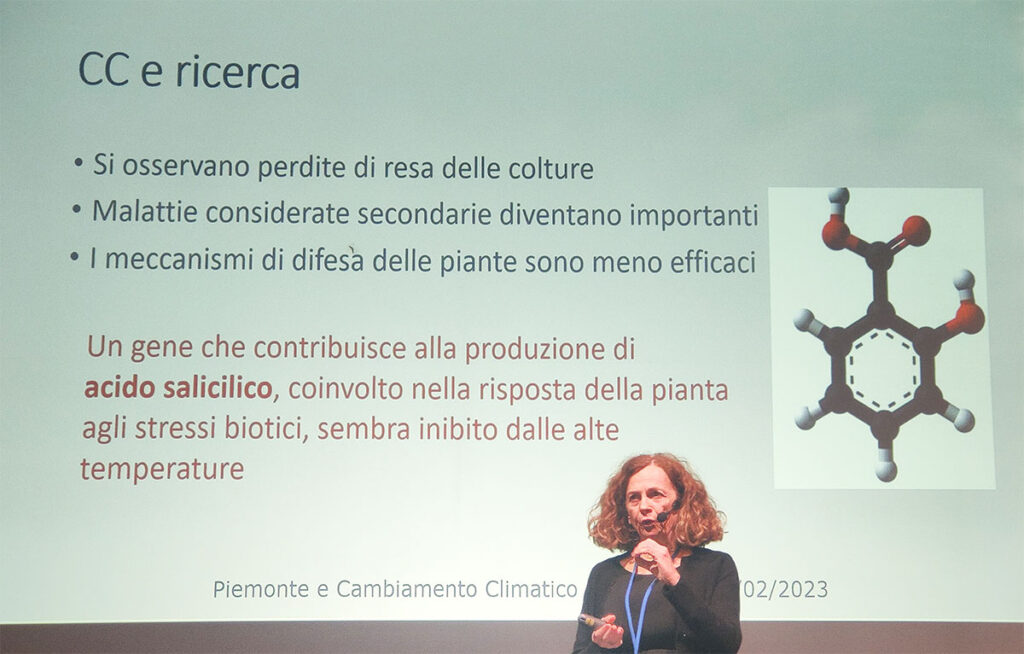
No good news from Paola either. The main points of her lecture:
- Yield reductions are observed in agriculture. I.e. we produce less food on the same surface;
- Diseases previously considered secondary ones become more and more important (and we don’t have enough efficient means to fight them);
- The plant’s defense mechanisms are also less efficient (as plants need time to adapt);
- It seems that (so not yet totally proven) a plant gene, responsible for the production of salicylic acid (pictured) that takes part in the plant’s response to biotic stresses, is inhibited by the high temperatures;

Luisella Celi, Turin University – Climate change and its impact on soil fertility
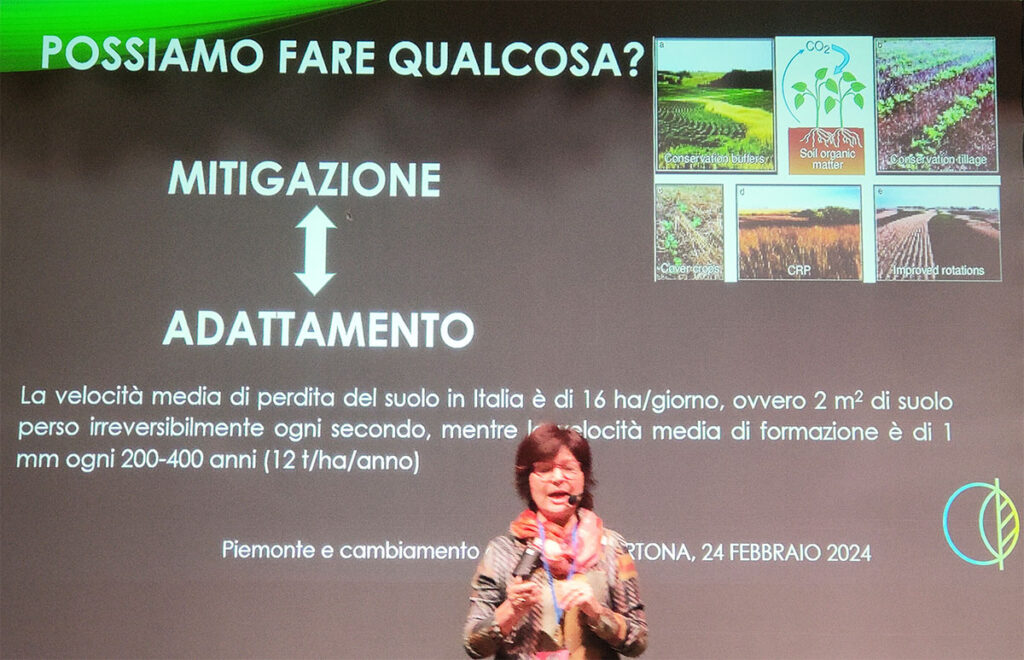
A horrendous observation by Luisella: the medium speed of soil loss in Italy is at the rate of 16 hectares per day, or 2 sq.m. of irreversibly lost (fertile) soil every second. While the medium speed of soil formation is 1 mm every 200-400 years (but I can’t interpret what 12 t/ha/anno means). This is scary, knowing the exact surface of agricultural land in Italy one could tell that sooner or later it will come to an end (and when exactly). Here I remember one of my favorite moments form “Men in Black”… – And he said the end of the world is coming” … and Agent K (Tommy Lee Jones) asks – Did he say when? Well, Luisella said it. What are we going to eat (and drink) then? (see my thoughts further in the article).
The next participant was Dario Giuseppe Airaudo from the regional government and he talked about Climate change evidence on wild fauna: the roe deer case. He pointed out that unlike plants the reproduction periods of the wild animals haven’t shifted (yet?). There is a specific grass that female roe deer eat after having given birth that contributes to specific qualities of their milk that help breed a healthy offspring. But the grass now starts growing earlier and by the deer’s birth period is already gone (or is not good enough for eating). That forced the roe deer to look for other habitats, for example moving up in the mountains where the same grass grows later. One problem is that not all of them find it immediately and that leads to young roe deer deaths and global decrease of roe deer population. The second problem is that mountains aren’t infinite either.
Luigi Ledda from the Polytechnic University of the Marche talked next about Agronomy and climate change adaptation of the cultural systems.

Claudio Lesca, Livanova – Energy, environment, sustainability: a difficult balance
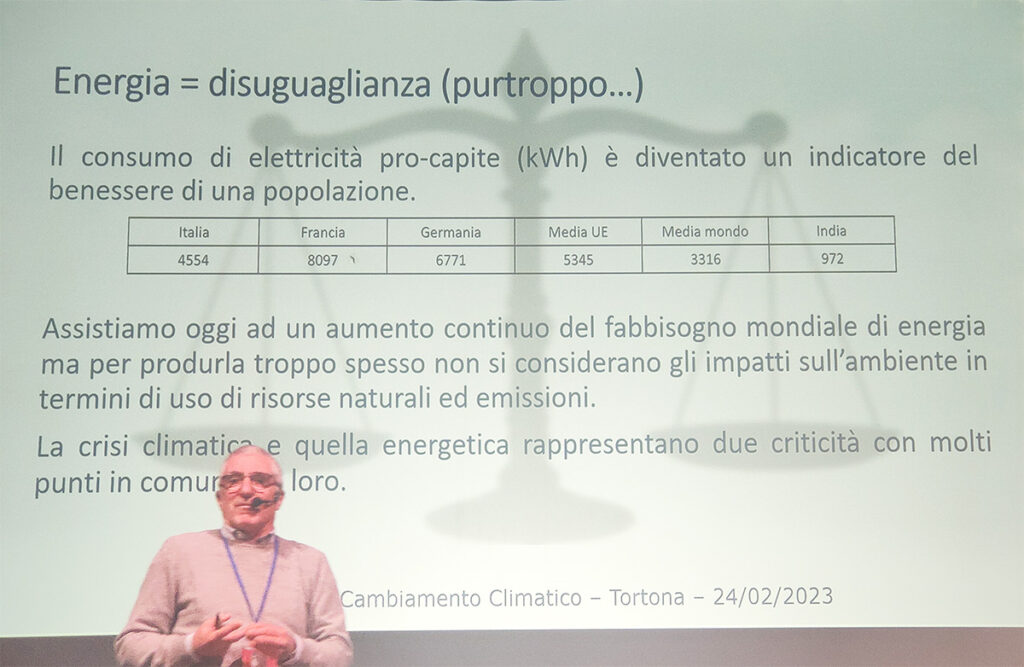
The table above is about the per capita electric energy consumption in various countries (in kWh) that has become an index of welfare. I was surprised to learn that Italy consumes nearly twice as less electricity than France and has a lower consumption rate than the EU-medium. Both countries have comparable population. Is this due to the fact that France is more industrial? Claudio said today we see a constant increase of the energy needs across the world but very often the environment impact in terms of natural resources usage and emissions are not considered.
The last speaker during the first part was the “ignorant meteorologist” Gianfranco Saffioti who made kind of a show about how man changes with climate change.
[my thoughts] Several participants repeated the “mantra” that cows are one of the main reasons for the climate change as they produce greenhouse gases. In this connection I would like to fully quote a post by Ian Wakley, a British farmer (very well prepared) in the Soil4Climate facebook group, published on October 22, 2022:
«Some simple figures that make the simple point, that meat and dairy is NOT the cause of our huge increases in both carbon and methane out put and their associated damage that’s bad for our environment and climate:
In 1950 there were
10.6 million cattle in the UK
50,225,000 people in the UK
4 million licensed vehicles on the roads
In 2018 there were
9.9 million cattle in the UK (with an annual average population of 10.9 million since 1950)
66,460.000 people in the UK
38 million licensed vehicles on the roads
There were no records of commercial flights in the 1950s but …
in 2004 there were 23 million commercial flights
in 2018 there were 38 million commercial flights
(this doesn’t include private or freight flights)
Let’s be clear here, the data that supposedly conclusively proves that cattle are the game changing contributor to global warming that the veganistas media would have us believe, is made up drivel.
What’s more, although those livestock stats are UK specific, they are also concurrent with global cattle numbers, which are lower now than at any time in almost the last 200 years»
Apart from the “veganistas media” pressure on society that eating meat is bad as cows are bad and killing them and other animals is cruel etc. there is a lot of discussion lately in Europe and in Italy in particular about meat substitues like crickets etc. Then Bill Gates in Trevor Noah’s podcast “What Now?” (November, 2023) declared «There could exist a world where machines can make all the food and the stuff» under the sauce that it could be beneficial for people as thus they’d need to work 3 days a week instead of five. Then, unexpectedly, at San Remo 2024 (the major song contest in Italy) Teresa Mannino launched an exhaustive monologue about how we destroy the planet, exploit the resources in a way that we shouldn’t etc. Italian analysts later explained that this was a carefully veiled veganista speech, they even invented a new more “obscure” term for this anti-meat movement but I can’t recall (neither find) it. Now, both Noah and Mannino are comedians. And lately comedians make quite successful political careers – take Beppe Grillo in Italy, or Slavi Trifonov in Bulgaria, or even Zelensky: people tend to believe them more and “swallow” with more easiness and less doubt what they say. As they can’t be serious, right? But…
Putting together all of the above, I can conclude the following:
- the climate change / global warming is a more or less cyclic natural process and it’s not the major problem – the problem is us, humans;
- we’ve become too many (plus 1 billion for the last 12 years) and continue to steadily reproduce (though slightly slower, scientists say);
- we need more and more energy but it’s still far from being all produced from renewable sources. And its production continues to pollute the planet;
- we need and will need more and more food, but we loose fertile soils at gigantic pace, yields go down not only because plants can’t adapt so fast under the climate changes, but also because the newly imposed methods of organic and sustainable agriculture (see tractor protests in Europe as of February / March 2024), having less in quantity and efficiency means to fight pests and diseases also lead to lower yields. So there will be less food anyway;
- the growing population needs to be fed by all means. That’s why we are being gradually but insistently lead (by comedians) to several connected thoughts: meat is bad (cows fart and killing them is not cool), crickets are good, machine produced food is also good (as thus you will work less). Not to speak how bad wine and alcohol in general are. While I was writing this article I read that “scientists warn” that cheeses like Brie or Camembert may disappear as the white mold suffers from the new climate and may not survive. So the general vector is that traditional food will sooner or later disappear. OR it will be available only for the richest (you’ve probably heard about the new Zuckerberg’s rancho in the Hawaii?)
Well, the only thing that I hope (and pray) for is that all of this shall not (totally) happen during my lifetime and of those of you that read this piece in 2024. As I love good food in general. And cheese. And meat. And wine. And probably I wouldn’t be able to live without all that. Cheers!

